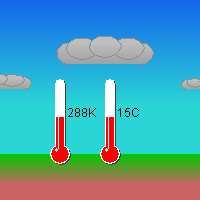| |
Hands-On, Minds-On Meteorology
Description
| Programming | Operation
| Controls
of Temperature
Description
The Controls of Temperature program is designed to allow students to
gain an appreciation for how the atmosphere's properties affect the
earth's global mean surface temperature.
|

click for whole shot |
Objectives
The primary objective of the Controls of Temperature application is
to demonstrate how global mean surface temperature changes when parameters
like amount of greenhouse gases, cloud cover, and cloud albedo are changed.
The secondary objective is to have students learn to interpret graphs
illustrating relationships between variables.
Programming
Theory
A three layer model problem (Ref: Wallace and Hobbs, 1977: Atmospheric
Science: An Introductory Survey. Academic Press, 467pp.; Problem
6.27) shown here was solved
to produce the expected global mean surface temperature given an incoming
solar radiation, atmospheric absorption, global cloud cover, and global
cloud albedo.
Assumptions
Any assumptions consistent with three layer atmospheric model.
All measurements are global!!
Equations
1) Cloud Albedo and Cloud Cover
Changing the cloud albedo and/or cloud cover resulted in a change
of incoming solar irradiance:
New SolarE = (1-((ap * ca) + 0.17 * (1 - cc)))*342
where cc = cloud cover(%) / 100,
ap = % of greenhouse gases / 100,
ca = global cloud albedo / 100, and
342 = solar irradiance in W/m2
this new incoming solar irradiance is then fed into the surface
temperature calculation
2) Surface Temperature
According to Wallace and Hobbs, 16 of 67 units, or (23.8%)
of the incoming solar radiation is absorbed by atmosphere.
Also, 22 of 28 units, or (78.6%) of the outgoing longwave radiation
is absorbed by atmosphere.
From the proof found above in the theory section,
E = (sigma*Temp)4 and so --> T= (E/sigma).25
so...
sfcTemp = Math.pow(([((solarE * term1) + (extraForcing*atmosPct))
/(B + 1)]/sigma),0.25);
where sigma = 5.67 x 10-8
and term1 = ((A*A) - (A*B) + A + 1) as seen in the proof for surface
E
and A = 1-alpha(shortwave); B = 1-alpha(longwave)
and atmosPct = percent of normal atmosphere
and extraForcing = extra forcing due to either or both of the doubling
of CO2 or water vapor in the atmosphere.
Other
N/A
Operation
Running the Program
- Click the link for Controls of Temperature.
- Changing '% of Greenhouse Gases' actually changes the absorption
properties of the atmosphere (in both long and short wave). For
example, if set at 40%, the absorption of long and short wave radiation
by the atmosphere would be 40% of normal.
- Changing cloud cover % simply changes the global percentage of
cloud cover. A nuance of this program is that you can set cloud
albedo to 100% and cloud cover to 100%. If this is done, no energy
reaches the Earth, and the surface temperature is 0K, regardless
of the % of greenhouse gases.
- Changing cloud albedo changes the global albedo of the clouds.
Visually, this is seen in the color presented on the tops of the
clouds. This feature is scaled by cloud cover and would therefore
have no effect if the cloud cover were set to 0%.
Extra Knowledge
Graphics
- Changing % of greenhouse gases does not cause a visual change.
- Changing cloud cover % changes the graphic to show no clouds
(0%) to clouds growing in size & covering the entire sky
(100%).
- Changing cloud albedo results in the clouds having a darker
top (0%) to a bright white top (100%).
- Thermometers giving temperatures both in Kelvin and degrees
Celsius are dynamic and correspond to the Global Mean Surface
Temperature displayed to the right of the graphic.
All data can be exported, graphed, and saved using the "Graphing
Tool".
 |
Department of Atmospheric Sciences
University of Illinois at Urbana Champaign
Created by Dan Bramer: Last Modified 07/27/2004
send questions/comments to bramer@atmos.uiuc.edu
|
|







